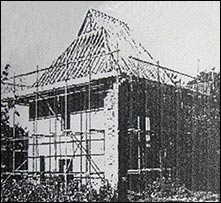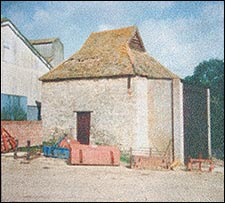|
|||||||
| Ann Cooper, 2007 |
|||||||
|
The Dovecote
|
|||||||
|
with special reference to Northamptonshire and Bedfordshire
|
|||||||
|
|
|||||||
|
The Dovecote or Pigeon House is an ancient, socially important, historical building. Unfortunately as time goes by, fewer and fewer are in preservation. Many, sadly, are in a derelict state and some even long gone and forgotten.
Strictly speaking it should be called a Pigeon House, as the majority of these were inhabited by pigeons, which are quite happy living in a large colony, whereas a dove would rather exist with its partner or just a small group of others. The Saxons would have known the dove but the pigeon was a later introduction by the Normans. "Fancy" pigeons had been bred by the Romans during their occupation, but these were merely decorative birds. There are many kinds of Dovecotes to be seen in this country, most of them on land that up until Tudor times, had been owned by the Lord of the Manor, or the Church, as these were the only establishments to be granted this privilege. They were always sheltered on the West and North sides, either with other buildings or trees. The entry always faced either South or West. There are also nearly as many theories as to the actual usage of the product of these buildings as there are buildings. The generally accepted one is that the birds were killed for the Manorial table during the winter to relieve the monotony of the salted meat and fish that was the usual fare on offer; also that the "squab" an immature bird, of about 28 days old, was offered as a delicacy during the breeding season, between March and October. (Pigeons can breed up to 8 times in the breeding season.) The pigeon is somewhat difficult to digest, it is said up to 24 hours; if eaten regularly "problems" were experienced! A Columbarius was in charge of the birds and their welfare. I suppose this also meant the catching and despatching when needed. Also the cleaning of the guano from the bottom of the building, this was a very valuable commodity as fertiliser for the land, having a chemical composition of 16% nitrogen 12% phosphoric acid and 3% potash by volume. Therefore a little went a long way. It is reckoned that a basket of pigeon dung is equal to a cartload of sheep dung. The dung was also used in the tanning process for stripping the hair off hides. The dovecotes vary in size, some up to 1500 nest boxes, or more, which meant a total of 2000 plus birds. The nest boxes are about 2 feet deep and usually begin about 3 feet from the ground in rows, with the nest entrances staggered, and a perching shelf between the rows. To get to the nest boxes the keeper would use a device called a 'Potence', which is rather like a crude revolving ladder. A main beam in the middle of the floor supports a cross member from which hang two vertical ladders and these can be revolved manually. The pigeons were capable of foraging for their own living, mostly at the expense of the Lord's neighbours. This caused a great deal of ill-will between the Manor and the peasants but there was nothing they could do other than send the children to scare the birds off. The penalty for taking a pigeon was the same as for taking a sheep - "death by hanging."
When I knew the building at Hinwick, it had been turned into a 'Granary'. The lower floor was earth and used as a general store, and an open stair up to a trap door led to a wooden floor on which grain was tipped to dry or store. I was told that in the middle of the 19th century it had been used as a malting floor to malt barley for beer making. The nest boxes had been partially blocked up. This Dovecote has been restored in recent years.
The first mention of Dovecotes in Rushden is in the inquisition of 1298. The income from them in 1313/1314 was a total of 7s.4d. Rushden in the 1327 survey lists one dovecote at Higham Park and another in Rushden, presumably at the Hall, and they were valued at 6s 8d. (A furlong near the Hall grounds in 1635 is identified as 'dufcote hill') These early buildings would most likely be circular with a conical roof, with walls about 3 feet thick. In 1374 repairs to them amounted to 2s 10d for beams and stakes and Is for wattles. A major restoration of The Park Dovehouse in 1428 cost £6.18s.1d. as a complete new roof was put onto the building with stone tiles. Attention was also made to the erosion by rain water falling from the roof and dripping onto the walls by putting up eavesboards. The Hall dovecote seems to have had no attention of any worth, as little is known of it until a document in 1735, the transfer of the Hall to Jeremy Sambrooke, when it is mentioned as part of the 24 acres of the Hall grounds. Also locally, there are the remains of the Castle Dovecote at Higham Ferrers which is now in the grounds of The Green Dragon, in College Street. March 11th 1800, a rental agreement was made between the Mayor and Capital Burgesses of Higham Ferrers and John Wyman of Higham Ferrers. The area covered by this agreement included the "Dovecotes". Tenancy was to commence April 5th 1800. February 4th 1812. The Town Stable and yard to the corner of the Dovecote, in Higham Ferrers was let to the "best bidder" - this was Mr. Eccles, (then Mayor of the town) for a 7 year term, at a rental of £2.12.0d. January 8th 1819. The above was once again let to the "best bidder" and on this occasion it was Mr. Robert Cole for £6.6.0d. Northamptonshire still has other fine dovecotes preserved, in varying states of repair. I suppose the finest must be The Tresham Dovecote at Newton-in-the-Willows, built about 1600 of stone and tile. There are two in Isham, somewhat smaller, and one at Grendon. All these buildings are rectangular with gable ends and quite high pitched roofs. At the Manor House at Rothersthorpe there is an unusual circular building with a fancy lantern. Other round buildings are at Wadenhoe and Harlestone. Bedfordshire also has its fair share of dovecotes in a similar state of repair. I suppose the most impressive is the one at Willington which has 1500 nest boxes. A rectangular building with spectacular gable ends, like steps and contains two chambers. It is said to have been built by John Gostwick from the ruins of Newnham Abbey which was closed in 1535. It is now in the hands of The National Trust. Ann Cooper, 2007 |
|||||||
|
|
|||||||
|
|
|||||||


